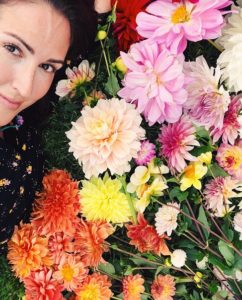Gardening on Camera
Gardener/photographer Elizabeth Griffin finds that photographing her garden is a useful discipline for achieving a more calculated and visually powerful landscape.
By Thomas Christopher
The camera sees a garden very differently than the human eye. That’s my conclusion after working as a garden journalist with photographers for the last 35 years. As a writer, I haven’t bothered to take visual images of my outdoor efforts myself. Now, though, I’m thinking that I really should start. For I am learning just how helpful to a gardener that can be.
One person who has persuaded me of the potential benefits of bringing the camera into the garden is Elizabeth Griffin. A veteran photo editor and photographer for publications such as Esquire magazine, Elizabeth has also been gardening since childhood at her parents’ retreat in Old Chatham, New York. This combination of interests served as a natural stepping-stone to the nearby Berkshire Botanical Garden, where she has been consulting on social media, and taking lots of photographs, since the spring of 2018. Recently, Elizabeth told me about how one interest serves the other.
In part, she says, she has come to rely on gardening as an antidote for the “ridiculous pace of media in New York City.” This, though, underlines an important distinction. The tendency of the human eye, Elizabeth explains, hers as well as mine, is to scan, moving back and forth, and only occasionally stopping to focus on some particular detail. This is especially true in our too-busy contemporary life. The camera, however, by its very nature is detail focused. Looking through it, Elizabeth says, forces her to slow down and be in the moment.
It also helps her to look in greater detail and more deeply at a garden. Framing the shots helps to determine what are the best views of a planting, to identify which are the most interesting angles and perspectives. You start editing right away, deciding what you want to include and what you want to leave out, decisions that have an obvious impact on garden design. Looking through a lens, you become absorbed in contrasts and harmonies of colors and textures, the contrasting heights of different plants, the variety in the shades of green.
Her own impulse as a gardener, Elizabeth admits, can be too inclusive. She becomes intrigued by all different sorts of flowers and tends to just throw them all together in the beds. Thinking about how the camera will see the results has become a useful discipline for achieving a more calculated and visually powerful arrangement. This is definitely a technique that would help me to tame my own excesses as a plant collector, to cultivate a simpler but aesthetically more powerful landscape.
Ever since she was little, Elizabeth has been inventing stories about what she sees in the garden. Taking photographs, at least for her, takes her to a similar place. While she is composing a photograph, there is always a dialogue going on inside her head. “What is the story I want to tell? What is the story I should be telling?” These are useful questions for the gardener, too.
Above all, a photograph is a recording of light, and looking through a camera can help the gardener to a better understanding of this critical resource. Gardeners generally qualify light only crudely, as ‘full sun’, ‘partial shade’, or ‘shade’. Photographs, though, reveal precisely the quality of the light and how it changes from moment throughout the day and through the seasons. In that respect, a camera can teach us to look more discriminatingly.
If you want to start your own photographic exploration, one way to do so would be to join the Berkshire Botanical Garden’s Photography Group. Just organized this spring, the Group includes photographers of different skill levels from beginner to expert and is open to Botanical Garden members. The benefits include not only the sharing of photographs, experiences, and expertise but also free access to the Botanical Garden’s grounds with all its inspiring plantings. For information about meeting times and membership, contact the garden by telephone at (413) 298-3926, or by email at info@berkshirebotanical.org.
Thomas Christopher is the co-author of “Garden Revolution” (Timber Press, 2016) and is a volunteer at Berkshire Botanical Garden. berkshirebotanical.org
Be-a-Better-Gardener is a community service of Berkshire Botanical Garden, one of the nation’s oldest botanical gardens in Stockbridge, MA. Its mission to provide knowledge of gardening and the environment through 25 display gardens and a diverse range of classes informs and inspires thousands of students and visitors on horticultural topics every year. Thomas Christopher is the co-author of Garden Revolution (Timber press, 2016) and is a volunteer at Berkshire Botanical Garden. berkshirebotanical.org.




